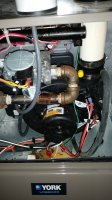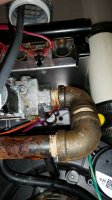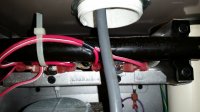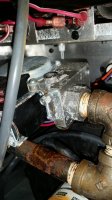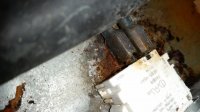Mark Lyons
New Member
I have a gas furnace in my house that was installed in December of 2014. Several days ago the circuit breaker for this unit tripped. In resetting the breaker the unit failed to respond. I decided to investigate by removing the combustion chamber panel only to find a puddle of water on the floor of the chamber. And sitting right in this puddle is a safety interlock switch (normally open) which shuts down the system if the panel on the blower compartment is removed.
I removed the blower panel then manually worked the switch's spring loaded plunger several times. There was a sizzling sound inside the switch and a wisp of smoke arose from it. This was obviously the cause of the breaker tripping but the more disturbing issue was the water that was emanating from the 2" PVC intake air pipe that enter the combustion chamber from above. This is the same pipe that brings outside air into the furnace when the unit is set for heating.
Every metal component directly below the entry of this PVC intake pipe is corroded; parts of the burners, the burner valve, and the steel gas pipe feeding the valve. There is water on the same components as well as electrical connectors on the wiring harness. Then there is that interlock switch mentioned earlier.
Since the unit is still under warranty, I called and left a voicemail message with the local HVAC contractor who installed the unit. I described the exact condition outlined above and asked why some sort of condensate trap had not been installed on the intake air pipe.
Later that afternoon the owner called me and told me that this has become a common problem with my type of unit. He went on to explain that it only occurs during hot humid weather in this part of the county (we are in Southern New Jersey). Then went onto say that the manufacturer (York) is reluctant to recognize this problem and thus has not offered a solution. He will be calling to schedule an appointment to try and remedy my problem this week. He said that he can install some sort of "gutter" device on the intake pipe to intercept the condensate collecting along inside wall of the pipe.
Has anyone else out there experienced this problem? IMO this is a disgrace that a big name manufacturer like York has overlooked the eventuality of this happening. I payed $4500 for this unit to have this happen. My last furnace was a Trane and I got 18 years out of it until the heat exchanger ended up with a possible breach in it. I hope that someone initiates a class action lawsuit against York. If I could get my money back on this piece of garbage, I'd have it removed and a Trane furnace installed.
I removed the blower panel then manually worked the switch's spring loaded plunger several times. There was a sizzling sound inside the switch and a wisp of smoke arose from it. This was obviously the cause of the breaker tripping but the more disturbing issue was the water that was emanating from the 2" PVC intake air pipe that enter the combustion chamber from above. This is the same pipe that brings outside air into the furnace when the unit is set for heating.
Every metal component directly below the entry of this PVC intake pipe is corroded; parts of the burners, the burner valve, and the steel gas pipe feeding the valve. There is water on the same components as well as electrical connectors on the wiring harness. Then there is that interlock switch mentioned earlier.
Since the unit is still under warranty, I called and left a voicemail message with the local HVAC contractor who installed the unit. I described the exact condition outlined above and asked why some sort of condensate trap had not been installed on the intake air pipe.
Later that afternoon the owner called me and told me that this has become a common problem with my type of unit. He went on to explain that it only occurs during hot humid weather in this part of the county (we are in Southern New Jersey). Then went onto say that the manufacturer (York) is reluctant to recognize this problem and thus has not offered a solution. He will be calling to schedule an appointment to try and remedy my problem this week. He said that he can install some sort of "gutter" device on the intake pipe to intercept the condensate collecting along inside wall of the pipe.
Has anyone else out there experienced this problem? IMO this is a disgrace that a big name manufacturer like York has overlooked the eventuality of this happening. I payed $4500 for this unit to have this happen. My last furnace was a Trane and I got 18 years out of it until the heat exchanger ended up with a possible breach in it. I hope that someone initiates a class action lawsuit against York. If I could get my money back on this piece of garbage, I'd have it removed and a Trane furnace installed.

